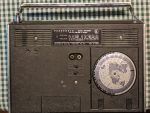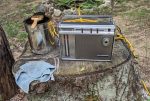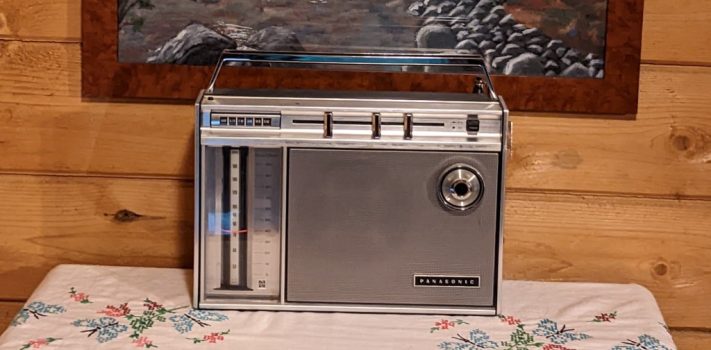Power is supplied by AC mains power or by 4 D batteries. The radio operates well using either power source.
 The radio has an antenna jack, an earphone jack, a phono jack, and an MPX out jack. It also has a switch for changing the speaker from the radio to the phono jack, and another switch for changing from AC to battery power. There is a moveable time zone dial on the cover of the AC power cord storage compartment. This implies that the radio might be useful for listening to shortwave broadcasts from around the world. Successfully listening to shortwave broadcasts involves knowing what times of day are best for listening, and knowing approximately where on the dial one is likely to find various stations. Being inexperienced in shortwave listening, I was not at first able to verify the effectiveness of the radio’s shortwave reception (more on that later).
The radio has an antenna jack, an earphone jack, a phono jack, and an MPX out jack. It also has a switch for changing the speaker from the radio to the phono jack, and another switch for changing from AC to battery power. There is a moveable time zone dial on the cover of the AC power cord storage compartment. This implies that the radio might be useful for listening to shortwave broadcasts from around the world. Successfully listening to shortwave broadcasts involves knowing what times of day are best for listening, and knowing approximately where on the dial one is likely to find various stations. Being inexperienced in shortwave listening, I was not at first able to verify the effectiveness of the radio’s shortwave reception (more on that later).
I expected to find the batteries dead and corroded when I opened the battery compartment. This was not the case. There was no corrosion, and the batteries still easily powered the radio. This was a surprise, since the batteries probably had not been changed since my Father passed away 11 years ago.
There is a button to activate the dial light while the radio is operating on battery power. The dial light remains constantly on when the radio is operating on AC power.
The radio includes a retractable antenna that seemed to improve FM and AM reception, and that I later found to be helpful with other bands as well.
There are also controls for Bass, Treble, and Volume. These are appropriate, because even my tin ear could recognize that the speaker puts out excellent sound. The only comparable quality sound that I have noticed in a similar-sized package is from a Bose Wave radio.
There is, of course, a power button. There are also gross and fine analog tuning dials. These are very useful, as the gross tuning dial allows one to find the signal, while the fine-tuning dial allows one to precisely hone in on the strongest portion of the signal.
There is also a band control dial, a squelch dial, and an AFC on/off button.
Similar used radios on eBay ran in the $150 to $250 range at the time of this writing, with the exception of one battered unit that was being sold “as is” for $51.29 plus $35.66 shipping.
The radio is very heavy for its size, weighing in at about 9 pounds complete with batteries. It measures approximately 11.5 X 8 X 3.75 inches. A nine-page service manual is available online.
They don’t make radios like this anymore. It is built like a tank. In a desperate situation, you could hit an attacker over the head with the radio. The attacker would cease to function. The radio might not.
The radio was made in Japan about 50 years ago or so. It is still in excellent condition.
Our dog does not at all like the squeaks and squawks that come out of the radio on certain bands. They raise the hackles on his back and cause him to howl in dislike. So the radio does not have the “Tucker the Beagle Seal of Approval.”
Consulting with “Sparks”
My friend, “Sparks”, is a radio virtuoso. He can tune a radio like Niccolo Paganini could tune a violin. As a highly qualified and highly active ham radio operator, he spends a lot of time developing his radio proficiency.
I asked Sparks to take a look at the RF-1600 to give me his impressions of it. I was especially eager to hear his thoughts regarding reception on the SW, MB, Air, and VHF bands.
Sparks was easily able to tune into broadcasts on all six bands and spoke highly of the quality of the radio. He mentioned that they don’t make them like this anymore, and that if they did, no one could afford to buy them. He was especially impressed by the excellent quality of the sound.
His major piece of advice was to store the radio without batteries in the compartment. Long-term storage with batteries in the compartment would likely to lead to potassium hydroxide leakage, which would lead in turn to corrosion.
The Football Test
It was a beautiful Saturday during Labor Day weekend. My wife and I were taking advantage of the wonderful weather to stain the tree house that we had made for our grandchildren.
 The process was taking longer than we expected, and it looked like it would cut into the start of our favorite college football game. We were planning to listen to the game on the radio, so we decided to just bring a radio outside and listen to the game while we continued to stain. I went into the house, grabbed the RF-1600, ran an extension cord from the pole barn to a nearby stump, and turned it on. I was quickly able to tune the radio to the station that would be carrying the game. Even though the volume was turned down quite low, the output from the speaker was very powerful. My wife asked me to turn it down even more, in case the neighbors wanted to listen to a different game. The nearest neighbors are far enough away that I did not think it would bother them, but I turned it down anyway.
The process was taking longer than we expected, and it looked like it would cut into the start of our favorite college football game. We were planning to listen to the game on the radio, so we decided to just bring a radio outside and listen to the game while we continued to stain. I went into the house, grabbed the RF-1600, ran an extension cord from the pole barn to a nearby stump, and turned it on. I was quickly able to tune the radio to the station that would be carrying the game. Even though the volume was turned down quite low, the output from the speaker was very powerful. My wife asked me to turn it down even more, in case the neighbors wanted to listen to a different game. The nearest neighbors are far enough away that I did not think it would bother them, but I turned it down anyway.
As I stood on the ladder and stained, I had no trouble clearly hearing every play of the game. The sound quality of the speaker was outstanding.
I was enjoying the excellent reception of the RF-1600 so much, that when I was done staining, I took the radio into the house. I plugged the cord into an outlet in the bathroom, and continued to listen to the game while I took a shower. Then I took it into the bedroom to listen to while I put on some clean clothes. Then I sat down, put my feet up, and listened to the end of the game.
My team won by a lot, which greatly enhanced my listening pleasure. But even if they had been losing, I would have had no basis to complain about the quality of the reception.
Uses
Based upon the performance of this radio, I would recommend it for tasks like listening to a college football game while working outside, or for listening for news while huddled in a tornado shelter. It is much too heavy and bulky for most field use, but could be easily transported in a vehicle.
Some Radio History
In 1888, Heinrich Rudolf Hertz first demonstrated the transmission of electromagnetic (radio) waves through air.
In 1894, Guglielmo Marconi began a series of developments that resulted in the first truly useful system for wireless telegraphy using radio waves.
In the fall of 1900, Reginald Fessenden made the first successful audio transmission using radio signals. Then on Christmas Eve, 1906, he made the first successful AM broadcast.
FM was patented by Edwin Armstrong in 1933.
Radio has been employed in a host of subsequent developments such as teletype, radiofax, television, and mobile telephony.
Conclusions
 The Panasonic RF-1600 provides great sound in a durable package for FM and AM signals. Good MW, SW, Air, and VHF reception depends partly on the skill of the operator. The unit is too heavy and bulky for most field use. It is best employed for home or vehicle use for standard radio listening or for use in short-term emergency situations.
The Panasonic RF-1600 provides great sound in a durable package for FM and AM signals. Good MW, SW, Air, and VHF reception depends partly on the skill of the operator. The unit is too heavy and bulky for most field use. It is best employed for home or vehicle use for standard radio listening or for use in short-term emergency situations.
Disclaimer
I did not receive any financial or other inducement to mention any vendor, product, or service in this article.










